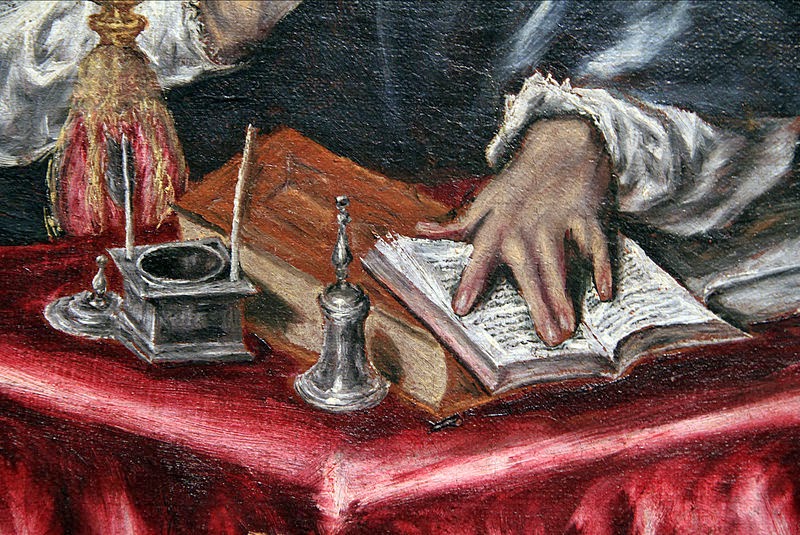 |
Ottavio Leoni, Portrait of Michelangelo Merisi da Caravaggio
c. 1621, Biblioteca Marucelliana, Firenze.[i] |
I just revisited the film Caravaggio (1886), directed by Derek Jarman, who also wrote the screen play.
My friend and colleague, Wilder Gómez, with whom I often exchange information and ideas, asked me what I thought of the film. I did not know what to answer; all I could remember was my feeling of awe when the film ended, and the two scenes that stuck in my mind: that of Caravaggio (Nigel Terry) lovingly combing the hair of dead Lena (Tilda Swinton), in preparation for the painting of Death of the Virgin, and the one of Jerusaleme (Spencer Leigh) crying beside Caravaggio's body and signing his last adieu; they were so moving, my heart shrank
and I was in tears.
During my second viewing this afternoon, I experienced the same emotions; simply said, the film is sublime, a work of art. It kept me captivated for one and a half hours, and I was, once again, moved by the same passages. What I had forgotten is the sombrous contraposition of Caravaggio's death with one of his best and most poignant paintings, The Entombment.
 |
Caravaggio, La Deposizione di Cristo (c. 1603)
Olio su tela, 300cm x 203cm, Musei Vaticani [ii] |
Jarman's motion picture not only narrates part of Caravaggio's life but also captures and communicates the nature of the painter's baroque style. The camera shots, as well as the source of light, are often oblique; the screenplay and its characters are so deprived of any idealisation, they can be gruesome; the light is often rendered in the typical caravaggesque chiaro-oscuro, which I take not only as a reference to the artist's style, but also as the filmmaker's reflexion on human nature. Needless to say, the scriptwriter fills some gaps in Carvaggio's biography and takes some poetic licence but, all through the film, his story remains plausible.
Thank you Wilder for triggering this new encounter with Derek Jarman's Carvaggio.
----------------------------------------------
Acabo de volver a
ver el film Caravaggio (1886) dirigido
por Derek Jarman, quien también escribió el guion.
Mi amigo y
colega, Wilder Gómez, con quién con frecuencia intercambio información e ideas,
me preguntó hoy que pensaba del film. La verdad es que no supe que responder.
Vi la película hace años y solamente podía recordar mi sobrecogimiento al final, y las dos escena que más me marcaron: en la primera, Carvaggio (Nigel Terry)
peina con mucho amor a Lena (Tilda Swinton) muerta, preparándola para la
pintura Muerte de la Virgen, y en la otra, Jerusalén
(Spencer Leigh) se despide con señas y llanto de su amo, Caravaggio, esta última es tan
conmovedora que me encogió el corazón y se me salieron las lágrimas.
Viendo el film por
segunda vez, viví las mismas emociones; simple y llanamente, el film es
sublime, una obra de arte. Me mantuvo
cautivada por una hora y media, y una vez más, el pasaje de la muerte de Lena y
la despedida de Jerusalén me conmovieron mucho. Lo que había olvidado por
completo es la contraposición de la muerte de Caravaggio con una de las mejores pinturas del artista, y la más impactante desde mi punto de vista , el Entierro de
Cristo.
 |
Caravaggio, La Deposizione di Cristo (c. 1603)
Olio su tela, 300cm x 203cm, Musei Vaticani [ii] |
La cinta de
Jarman no solo narra parte de la vida de Caravaggio sino que, al mismo tiempo,
captura y comunica el carácter del barroco caravaggesco.
Las tomas de la cámara y la fuente de luz son con
frecuencia oblicuas; el guión y sus personajes son
tan faltos de idealización que resultan repugnantes con frecuencia; la luz es
representada con el típico chiaro-oscuro de
Caravaggio, que es fácil interpretar no solo como alusión al estilo del artista, sino también como reflejo de la naturaleza humana.
Naturalmente, el cineasta llena algunos vacíos en la historia del pintor y se permite alguna licencia poética, pero la historia es consistentemente y plausible a lo largo del film.
Gracias Wilder por provocar este nuevo encuentro con el Caravaggio de Derek Jarman.
[i]Source: Comune di Milano in: http://commons.wikimedia.org/wiki/File:Bild-Ottavio_Leoni,_Caravaggio.jpg Retrieved on February, 21, 2014. According to Wikimedia Commons: "This work is in the public domain in the United States, and those countries with a copyright term of life of the author plus 100 years or less." And, "This file has been identified as being free of known restrictions under copyright law, including all related and neighboring rights."
[ii] Source: http://commons.wikimedia.org/wiki/File:The_Entombment_of_Christ-Caravaggio_(c.1602-3).jpg Retrieved: February 21, 2014. According to its source: "This work is in the public domain in the United States, and those countries with a copyright term of life of the author plus 100 years or less." And, "This file has been identified as being free of known restrictions under copyright law, including all related and neighboring rights."






